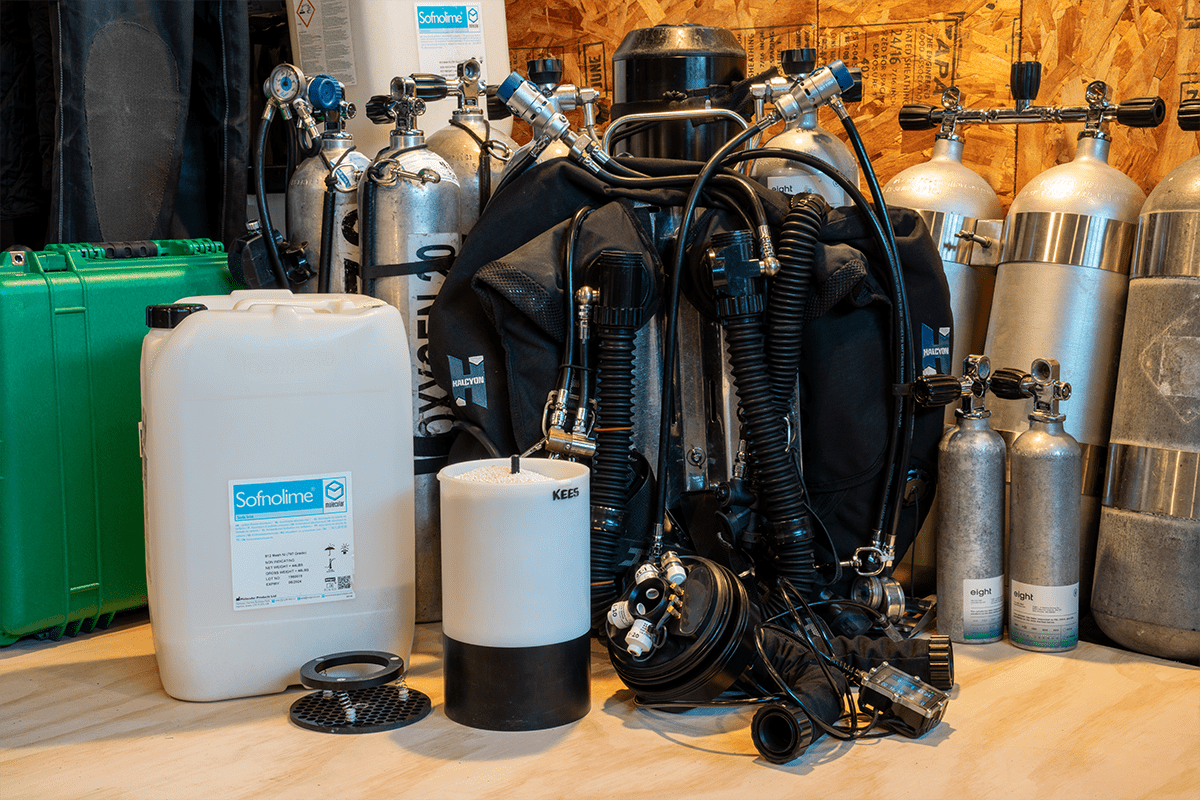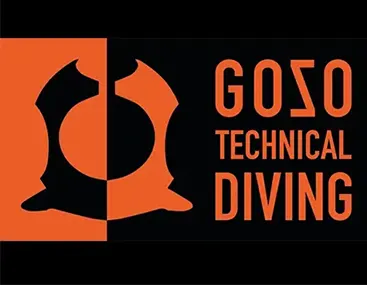Education
Estimating Your Scrubber Duration
Global Underwater Explorers (GUE) rebreather divers use the Absorbent Canister Endurance (ACE) method for estimating scrubber duration.

Reprinted from GUE’s CCR Standard Operating Procedures.
Header photo: JJ-CCR in GUE configuration with twin seven-liter diluent cylinders, Photo by Kees Beemster Leverenz.
Global Underwater Explorers (GUE) rebreather divers use the Absorbent Canister Endurance (ACE) method for estimating scrubber duration. The volume of CO2 produced by a diver is variable and incremental in relationship to the level of exercise, and consequently the diver’s Respiratory Minute Volume (RMV). If you know your RMV, you can estimate your O2 consumption (VO2) and CO2 produced (VCO2) and finally, your Absorbent Canister Endurance (ACE). The calculation shown below is for the JJ-CCR [Ed. note: GUE has standardized on the JJ-CCR with a specific configuration] but can be applied to other units including those with radial scrubbers.

Follow these steps:
1. Theoretical Absorbent Capacity (TAC) Molecular Products Sofnolime 797 (1.0-2.5 mm granular size), which is recommended for use with the JJ-CCR, has a Typical Usage Capacity (TUC) of 150 liters of CO2/kg of sofnolime. The standard axial absorbent canister in the JJ-CCR contains 2.5 kg to 2.7 kg of sofnolime when it is properly packed. Based on these numbers the Theoretical Absorbent Capacity (TAC) is calculated using the following formula:
Formula
TAC = TUC x kg
Example: 2.7 liters Sofnolime 797
TAC = 150 x 2.7
TAC = 405 liters of CO2 can, in theory, be absorbed.
2. Volume of Oxygen Consumed per Minute (VO2) The ratio of VO2 consumption to Respiratory Minute Volume (RMV) is about 4.0% and are indicative of what would be expected of divers performing graded exercise underwater.1
VO2 = RMV x 0.04
3. Volume of Carbon Dioxide Produced per Minute (VCO2) For practical purposes, the VCO2 production, and the VO2 consumption, are assumed to be equal (respiratory exchange rate 1:1).
The ratio of VCO2 consumption to Respiratory Minute Volume (RMV) is about 4.0% and are indicative of what would be expected of divers performing graded exercise underwater.2
Formula
VCO2 = RMV x 0.04
Example 1: RMV 40 lpm Example 2: RMV 20 lpm
VCO2 = 40 x 0.04 VCO2 = 20 x 0.04
VCO2 = 1.6 lpm VCO2 = 0.8 lpm
4. Real Absorbent Canister Capacity (RAC)
The Real Absorbent Canister Capacity (RAC) varies depending on your actual RMV. A lower RMV equates to a longer dwell time and consequently better CO2 absorption. The estimated percentages below are based on tests conducted by GUE.
20 lpm RMV = 95% of the Theoretical Absorbent Capacity (TAC)
30 lpm RMV = 85% of the Theoretical Absorbent Capacity (TAC)
40 lpm RMV = 80% of the Theoretical Absorbent Capacity (TAC)
Example 1: RMV 40 lpm and VCO2 1.6 lpm
RAC = TAC x 0.8
RAC = 324 liter CO2 (The amount of liters of CO2 the absorbent canister can absorb under real world conditions). This compares to theoretical absorption capacity, TAC=405 liters CO2.
Example 2: RMV 20 lpm and VCO2 0.8 lpm
RAC = TAC x 0.95
RAC = 384.75 liter CO2 (The amount of liters of CO2 the absorbent canister can absorb under real world conditions), compared to the theoretical limit.
5. Absorbent Canister Endurance (ACE) The estimated absorbent canister endurance (ACE) can now be calculated, based on the diver’s average VCO2.
Formula
ACE = RAC ÷ VCO2
Example 1: RMV 40 lpm, VCO2 1.6 lpm and 324 liter RAC
ACE = 324 ÷ 1.6
ACE = 202.5 min
Example 2: RMV 20 lpm, VCO2 0.8 lpm and 384 liter RAC
ACE = 384 ÷ 0.8
ACE = 480.9 min
This should provide an estimate of the expected duration of your scrubber.
Footnotes
1: U.S. Navy Experimental Diving Unit Report 3-81 Standardized NEDU Unmanned UBA Test Procedures and Performance Goals. James R. Middleton. Edward D. Thalmann. July 1981
2. U.S. Navy Experimental Diving Unit Report 3-81 Standardized NEDU Unmanned UBA Test procedures and Performance Goals. James R. Middleton. Edward D. Thalmann. July 1981




















































